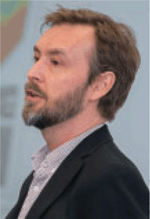The evolution of FWI and its perceived benefits
Tony Martin A C and Andrew Long BA PGS, 4 The Heights, Brooklands, Weybridge, UK, KT12 5JY.
B PGS Australia Pty Ltd, Level 4, IBM Centre, 1060 Hay Street, West Perth WA 6005.
C Corresponding author. Email: tony.martin@pgs.com
The APPEA Journal 59(1) 432-443 https://doi.org/10.1071/AJ18038
Submitted: 6 December 2018 Accepted: 8 February 2019 Published: 17 June 2019
Abstract
Despite the mathematics behind full waveform inversion (FWI) being published in the early 1980s, it was 30 years before the method could be efficiently implemented on the scale of conventional 3D marine seismic volumes. FWI has evolved from using only transmitted waves and being constrained because towed streamer data lacked the very long offsets and ultra-low frequencies necessary to derive stable velocity updates beyond shallow depths. FWI now uses the full seismic wavefield (both transmitted and scattered wavefields), recovers deep velocity updates for standard offsets and frequencies and increasingly uses a wider range of frequencies that contribute to seismic imaging. We use several case examples to consider the benefits and caveats for robust FWI application: for resolving near-surface features and reducing seismic imaging uncertainty in areas with complex overburden heterogeneities; for resolving near-surface features and improving volumetric estimates; for using an enlarged bandwidth to resolve small model features; for updating the velocity in high contrast regimes; and for the creation of survey-wide, high-resolution models to reduce imaging uncertainty, complement attribute analysis, estimate elastic properties and prospect derisking. Collectively, we demonstrate how to produce high-resolution velocity models when conventional methods cannot and how to generate earth models in an accelerated fashion to reduce project turnaround. We describe pragmatic limits to what maximum FWI frequencies are reasonable and suggest ways that may soon by-pass signal processing and obtain direct earth attributes.
Keywords: evolution, full waveform inversion, imaging, uncertainty, velocity models.

Tony Martin works for PGS in the role of Principal Geophysicist. He has 25 years’ industry experience working for both contractors and operators, and has worked in various locations around the world. He has been published on more than 25 occasions. He is a member of the EAGE and SEG, and is an Associate Editor of Geophysics. |

Andrew Long has degrees in Physics and Geophysics from Melbourne University and Curtin University and a PhD in Geophysics from the University of Western Australia. He was a postdoctoral researcher at Stanford University in the US before joining PGS in 1997, where he is now Chief Scientist and Technology Analyst. He is a member of PESA, ASEG, EAGE, SEG and SEAPEX. |
References
Alkhalifah, T. (2015). Conditioning the full-waveform inversion gradient to welcome anisotropy Geophysics 80, R111–R122.| Conditioning the full-waveform inversion gradient to welcome anisotropyCrossref | GoogleScholarGoogle Scholar |
Brandsberg-Dahl, S., Chemingui, N., Valenciano, A. A., Ramos-Martinez, J., and Qui, L. (2017). FWI for model updates in large-contrast media. The Leading Edge 36, 81–87.
| FWI for model updates in large-contrast media.Crossref | GoogleScholarGoogle Scholar |
Feuilleaubois, L. O., Charoing, V., Maioli, A., and Reiser, C. (2017). Utilizing a novel quantitative interpretation workflow to derisk shallow hydrocarbon prospects — a Barents Sea case study. First Break 35, 85–92.
Guo, Z., and de Hoop, M. V. (2013). Shape optimization and level set method in full waveform inversion with 3D body reconstruction. In ‘SEG International Exposition and 83rd Annual Meeting, Houston, 22–27th September 2013’. pp. 1079–1083. (SEG: Houston, TX). Available at https://library.seg.org/doi/abs/10.1190/segam2013-1057.1 [Verified 25 February 2019]
Lailly, P. (1983). The seismic inverse problem as a sequence of before stack migrations. In ‘Proceedings of the Conference on Inverse Scattering: Theory and Application, Tulsa, 16–18 May 1983’. pp. 206–220. (SIAM: Tulsa, OK).
Martin, T., Pendred, G., Vermeulen, J., Bell, M., and Mellar, P. (2017). A robust FWI method for model updating in high contrast bodies. In ‘79th EAGE Conference and Exhibition, Paris, 12–15 June 2017’. Th B1 09. (EAGE: Paris, France).
Qiu, L., Chemingui, N., Zou, Z., and Valenciano, A. A. (2016). Full-waveform inversion with steerable variation regularization. In ‘SEG International Exposition and 86th Annual Meeting, Dallas, 19–21 October 2016’. pp. 1174–1178. (SEG: Dallas, TX). Available at https://library.seg.org/doi/abs/10.1190/segam2016-13872436.1 [Verified 25 February 2019]
Qiu, L., Ramos-Martinez, J., Valenciano, A. A., Yang, Y., and Enquist, B. (2017). Full-waveform inversion with an exponentially encoded optimal transport norm. In ‘SEG International Exposition and 87th Annual International Meeting, Houston, 24–29 September 2017’. pp. 1286–1290. (SEG: Houston, TX). Available at https://library.seg.org/doi/abs/10.1190/segam2017-17681930.1 [Verified 25 February 2019]
Ramos-Martinez, J., Crawley, S., Zou, Z., Valenciano, A. A., Qui, L., and Chemingui, N. (2016). A robust gradient for long wavelength FWI updates. In ‘78th EAGE Conference and Exhibition, Vienna, 30 May–2 June 2016’. SRS2. (EAGE: Vienna, Austria).
Ramos-Martinez, J., Shi, J., Qiu, L., Valenciano, A. A., and Chemingui, N. (2017). Multi-parameter FWI – Long-wavelength updates and leakage reduction in acoustic anisotropic media. In ‘79th EAGE Conference and Exhibition, Paris, 12–15 June 2017’. Tu A3 13. (EAGE: Paris, France)
Ramos-Martinez, J., Qiu, L., Kirkebø, J., Valenciano, A. A., and Yang, Y. (2018). Long-wavelength FWI updates beyond cycle skipping. In ‘SEG International Exposition and 88th Annual International Meeting, Anaheim, 14–19 October 2018’. pp. 1168–1172. (SEG: Anaheim, CA). Available at https://library.seg.org/doi/abs/10.1190/segam2018-2998433.1 [Verified 25 February 2019]
Reiser, C., Martin, T., Long, A., and Naumann, S. (2018). Integration of high resolution FWI velocity model and broadband data for elastic property generation: A low frequency overlap case study in the Norwegian Sea. In ‘1st EAGE Conference on Reservoir Geoscience, Kuala Lumpur, 3–5 December 2018’. (EAGE: Kuala Lumpur, Malaysia).
Rønholt, G., Korsmo, Ø., Naumann, S., Marinets, S., Brenne, E., and Abbasi, M. F. (2015). Complete wavefield imaging for lithology and fluid prediction in the Barents Sea. In ‘SEG International Exposition and 85th Annual International Meeting, Tulsa, 18–23 October 2015’. pp. 4070–4074. (SEG: Tulsa, OK). Available at https://library.seg.org/doi/abs/10.1190/segam2015-5869968.1 [Verified 25 February 2019]
Sirgue, L., Barkved, O. I., Van Gestel, J. P., Askim, O. J., and Kommedal, J. H. (2009). 3D Waveform Inversion on Valhall Wide-azimuth OBC. In ‘71st EAGE Conference and Exhibition, Amsterdam, 8–11 June 2009’. U038. (EAGE: Amsterdam, Netherlands).
Tarantola, A. (1984). Inversion of seismic reflection data in the acoustic approximation Geophysics 49, 1259–1266.
| Inversion of seismic reflection data in the acoustic approximationCrossref | GoogleScholarGoogle Scholar |
Wang, M., Xie, Y., Xu, W. Q., Xin, K. F., Chuah, B. L., Loh, F. C., Manning, T., and Wolfarth, S. (2016). Dynamic-warping full-waveform inversion to overcome cycle skipping. In ‘SEG International Exposition and 86th Annual International Meeting, Dallas, 19–21 October 2016’. pp. 1273–1276. (SEGL Dallas, TX). Available at https://library.seg.org/doi/abs/10.1190/segam2016-13855951.1 [Verified 25 February 2019]
Warner, M., and Guasch, L. (2014) Adaptive waveform inversion: Theory. In ‘SEG International Exposition and 84th Annual International Meeting, Denver, 26–31 October 2014’. pp. 1089–1093. (SEG: Denver, CO). Available at https://library.seg.org/doi/abs/10.1190/segam2014-0371.1 [Verified 25 February 2019]
Whitmore, N. D., and Crawley, S. (2012). Application of RTM inverse scattering imaging conditions. In ‘SEG International Exposition and 82nd Annual International Meeting, Las Vegas, 4–9 November 2012’. pp. 1–6. (SEG: Las Vegas, NV). Available at https://library.seg.org/doi/abs/10.1190/segam2012-0779.1 [Verified 25 February 2019]
Xu, S., Wang, D., Chen, F., Zhang, Y., and Lambare, G. (2013). Full waveform inversion for reflected seismic data. In ‘74th EAGE Conference & Exhibition Incorporating SPE EUROPEC, Copenhagen, 4–7 June 2012’. W024. (EAGE: Copenhagen, Denmark).
Yang, Y., and Engquist, B. (2017). Analysis of optimal transport and related misfit functions in full-waveform inversion Geophysics 83, A7–A12.
| Analysis of optimal transport and related misfit functions in full-waveform inversionCrossref | GoogleScholarGoogle Scholar |


